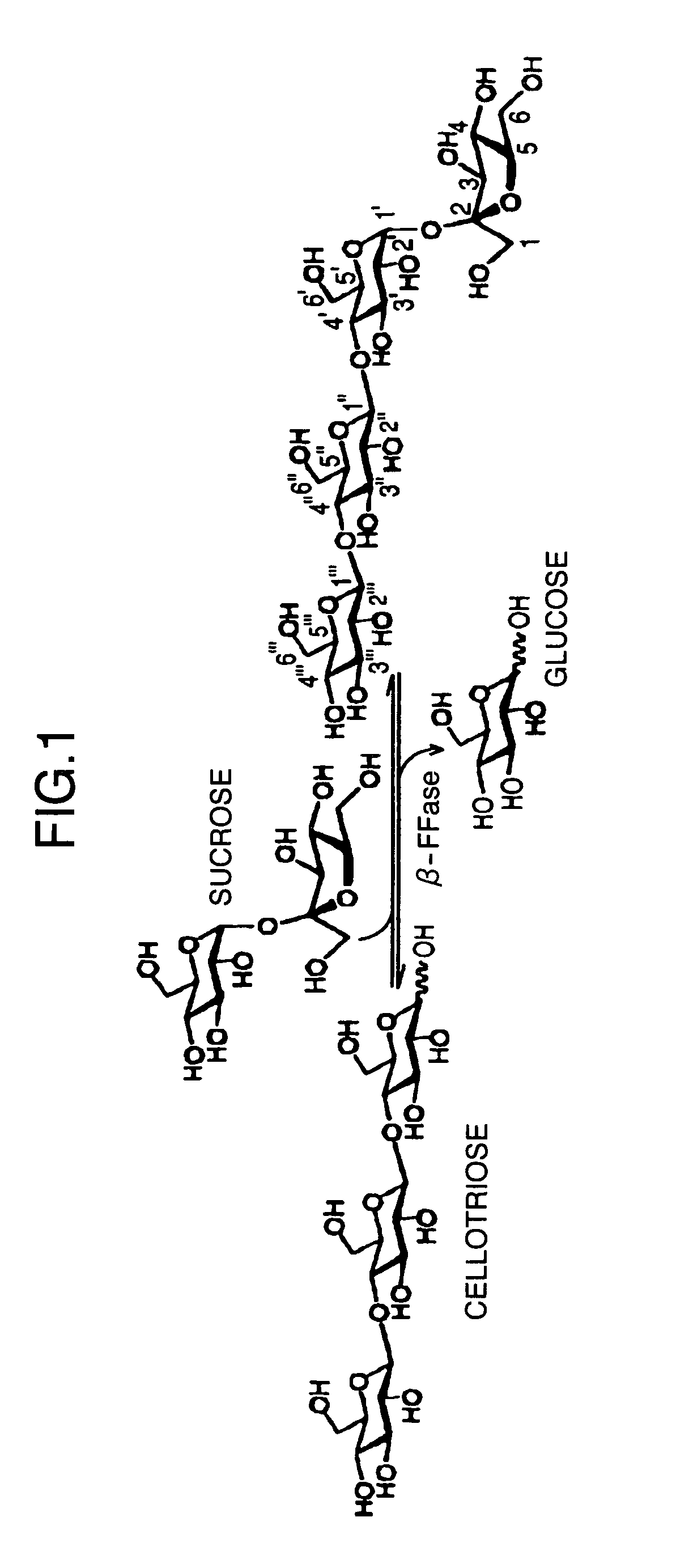Nonreducing beta-glucan derivative
- Summary
- Abstract
- Description
- Claims
- Application Information
AI Technical Summary
Benefits of technology
Problems solved by technology
Method used
Image
Examples
production example 1
[0075]To a general agar slant medium, Arthrobacter globiformis NBRC 3062 (FERM deposition No. BP-10159) was inoculated, cultured at 37° C. for 2 days. Thereafter; an aliquot was taken from the cultured product by a platinum loop, inoculated in a medium consisting of a composition of 1% of poly peptone, 0.2% of yeast extract, and 0.1% of MgSO4, and incubated at 30° C. for 2 days while shaking under aeration. The culture solution was centrifuged, and the supernatant was subjected to DEAE-toyopearl 650M chromatography, further the eluate was subjected to Toyopearl HW-55 gel-filtration and then FPLC chromatography to obtain a purified enzyme.
example 1
[0076]To 5% of sucrose and 5% of cellotriose (manufactured by Aldrich), the purified enzyme produced in Production Example 1 was added. The solution was allowed to react in a phosphate buffer (pH 7.0), at 37° C. for 20 hours to obtain a transglucosylated cellotriose wherein fructose is binding to the reducing end thereof. The structure of transglucosylated cellotriose was confirmed by proton NMR and carbon NMR (FIG. 1 and Table 1).
[0077]Whether fructose was bound was confirmed based on an increase of a peak [180-18] in a mass spectrum and a storage stability test of an equivalent mixture of the obtained transglucosylated product and L-arginine contained at 40° C. and 75% RH, airtight for 2 weeks. A decrease ratio in degree of whiteness was 2% (it was 99% at the onset and 97% after the test). White color in appearance was maintained.
[0078]Two mg of the transglucosylated product thus obtained was introduced in a cylindrical mortar of φ8 mm, and compressed by a flat-surface punch of φ8...
example 2
[0081]To 1.25% of sucrose and 1.25% of β-glucan having 40 glucose residues, the purified enzyme obtained in Production Example 1 was added. The mixture was allowed to react in a phosphate buffer (pH 7.0) at 37° C. for 9 hours to obtain a transglucosylated product wherein fructose is binding to the reducing end of the β-glucan having 40 glucose residues.
[0082]Whether fructose was bound was confirmed based on an increase of a peak [180-18] in a mass spectrum and a storage stability test performed by an equivalent mixture of the obtained transglucosylated product and L-arginine contained at 40° C. and 75% RH, airtight for 2 weeks. A decrease ratio in degree of whiteness was 3% (it was 99% at the onset and 96% after the test). White color in appearance was maintained.
[0083]A molded cylindrical product was prepared at a compression pressure of 1 kN in the same manner as in Example 1 and the hardness and disintegration time were determined. As a result, the hardness and the disintegration...
PUM
| Property | Measurement | Unit |
|---|---|---|
| Temperature | aaaaa | aaaaa |
| Pressure | aaaaa | aaaaa |
| Cell angle | aaaaa | aaaaa |
Abstract
Description
Claims
Application Information
 Login to View More
Login to View More - R&D
- Intellectual Property
- Life Sciences
- Materials
- Tech Scout
- Unparalleled Data Quality
- Higher Quality Content
- 60% Fewer Hallucinations
Browse by: Latest US Patents, China's latest patents, Technical Efficacy Thesaurus, Application Domain, Technology Topic, Popular Technical Reports.
© 2025 PatSnap. All rights reserved.Legal|Privacy policy|Modern Slavery Act Transparency Statement|Sitemap|About US| Contact US: help@patsnap.com

